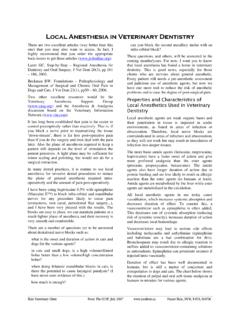Transcription of Using the Surface Electrocardiogram to Localize the Origin ...
1 REVIEWU sing the Surface Electrocardiogram to Localize theOrigin of Idiopathic Ventricular TachycardiaKYOUNG-MIN PARK, , ,*, YOU-HO KIM, , , and FRANCIS E. MARCHLINSKI, From the*Department of Internal Medicine, Konkuk University Hospital, Konkuk University School of Medicine,Seoul, South Korea; Section of Cardiac Electrophysiology, Department of Medicine, Hospital of the University ofPennsylvania, Philadelphia, Pennsylvania; and Asan Medical Center, Department of Internal Medicine, Universityof Ulsan College of Medicine, Seoul, South KoreaThe Surface Electrocardiogram (ECG) is a useful tool to help identify the sites of Origin of ventriculartachycardia (VT). Despite such limitations as chest wall deformity and metabolic and drug effects, theanalysis of the QRS morphologic patterns and vectors can discern the site of activation of have been described numerous reports about ECG features of idiopathic left- and right-ventricularVT.
2 In this review, we summarized typical ECG characteristics according to the VT sites of Origin basedon previous reports, with anatomical considerations of the left and right ventricles, including the outflowtracts and epicardium. (PACE 2012; 35:1516 1527) Electrocardiogram ,VT,Ablation,elect rophysiology - clinicalIntroductionIdiopathic ventricular tachycardia (VT) isrecognized as a ventricular arrhythmia (VA)without an apparent structural heart disease andaccounts for approximately 10% of all patientsreferred for an evaluation of VTcommonly arises from the outflow tract (OT)of the right ventricle (RV) and left ventricle(LV), but it also can involve the fascicles ofthe specialized conduction system in the LV,the mitral and tricuspid annuli, or the anteriorand posterior papillary muscles (PPM) in the VT can arise from the endocardium of theRVOT and LVOT below the semilunar valves,above the pulmonic valve, or within the aorticsinuses of Valsalva (ASOV).
3 Rarely, idiopathicVT has an epicardial Origin . Past decades haveseen a tremendous increase in our understandingof the Origin and mechanisms of monomorphicVT, as well as in our ability to successfullytreat these arrhythmias by catheter mappingand ablation. Central to this progress was thegrowing interest about the anatomical basis ofVAs and the recognition of the role of the 12-lead Electrocardiogram (ECG) as a mapping tool(Table I). Prior detailed knowledge about theAddress for reprints: Kyoung-Min Park. , Division ofCardiology, Department of Internal Medicine, Konkuk Uni-versity School of Medicine, 120-1 Neungdong-ro, Hwayang-dong, Gwangjin-gu, Seoul 143 729, South Korea. Fax: 82-2-2030-8363; e-mail: March 28, 2012; revised May 15, 2012; accepted May31, : features of the Surface ECG regardingdifferent sites of VT Origin is essential for choosingthe optimal ablation method and improving thechances salient loca ablation success.
4 In thisreview, we will look at the salient ECG featuresof idiopathic VT that aid in localization and willguide to design for ablation ConsiderationsThe QRS complex during idiopathic VT isgenerated from a distant site of Origin followedby spread of activation away from the focus. Somegeneral principles related to ventricular geometryand activation governs the ECG patterns seen inVT. First, left ventricular free wall VT shows aright bundle branch block (RBBB) configuration,while VT exiting from the interventricular septumor right ventricle displays a left bundle branchblock (LBBB) configuration. Second, septal exitsare associated with narrower QRS complexes con-sistent with synchronous rather than sequentialventricular activation. Third, basal sites showpositive precordial concordance, while negativeconcordance is seen in apical sites of Origin .
5 TheQRS axis varies with exit shifts predominantlyalong a superoinferior axis but right-left shiftscan also occur. Anatomical variation is the othermain factor that can cause disruption to expectedpattern of body Surface electrical vector for agiven arrhythmia Origin . This can arise fromtranslational, rotational, or attitudinal shifts in thenormal relationship of the heart to the chest wall,or from variations within the cardiomediastinalanatomy itself. Antiarrhythmic drugs, by affectingC 2012, The Authors. Journal compilationC 2012 Wiley Periodicals, 2012 PACE, Vol. 35 USE OF Surface ECG TO Localize THE Origin OF IDIOPATHIC VTTable Features of Idiopathic Ventricular TachycardiasLocalizationPrecordialof VTBBBAxisTransitionV1V6 IOther ECG FeaturesLeft ventricleASOVLCCLBBBI nferior V2rS,RSRrSNotchedMorWinV1,QSorRS in lead IRCCLBBBI nferior V3rS, RSRRE arly transition, broad R inV2, positive in V1 LCC/RCCjunctionLBBBI nferiorV3qrSRR/Rsr Notched on the downwarddeflection in V1or w patternLVOTS eptal sitesLBBBLeft inferiorEarlyQS/QrRsRsRatio of QS in II and III>1 AMCRBBBI nferiorNoneqRRR/RsPositive precordialconcordance and no S in V6 MAAnterolateralRBBBI nferiorEarlyRRsQS/rSLate inferior lead notching.
6 Wider QRS, late S wavePosteriorRBBBS uperiorEarlyRRsRsAbsence of notching ininferior leadsEpicardialAIV/GCVjunctionLBBBI nferiorEarlyrS/QSRrSPrecordial pattern break withabrupt loss of R waves inV2:MDI> superiorEarlyVariableRRsPositive concordance V2-V6;MDI> ; slurredintrinsicoid deflectionPapillary musclePosteromedialRBBBS uperiorVariablersRRSRLate R to S precordialtransitionAnterolateralRBBBI nferior<V1rsRRSSqR/qr pattern in lead aVRandrS pattern in lead V6 FascicularLeft posteriorRBBBLeft superiorEarlyrsRRSQLoss of late precordial Rwaves with more apicalexitsLeft anteriorRBBBR ightNonersRRSQS imilar to posterior fascicularapart from axisUpper septalLBBBN ormal or rightV3rSRsRsNarrow QRS complex with VAdissociationRight ventricleRVOTA nterial, septalLBBBI nferior V3rSRrSEarly transition with lead Inegative, isoelectric, ormultiphasicPosterior, freewallLBBBI nferior V3rSRRLate transition.
7 Broad latenotched inferior leads andlead I positiveParahisianLBBBI nferior>V3 QSRRI soelectric or positive aVL,large R amplitude in I, V5and V6, taller inferior RcontinuedPACE, 20121517 PARK, ET VTBBBAxisTransitionV1V6 IOther ECG FeaturesPALBBBI nferior>V3rS/QSRrS/QS1>aVL/aVRratioofthe Q-wave amplitude, 1<R/SratioinleadV2 TASeptalLBBBI nferior<V3 QSRR/rPositive, isoelectric, ormultiphasic in aVLFree-wallLBBBV ariableV4-V5rSRR/rNotching in limb leads;discordant forces in inferiorleads if inferiorAIV=anterior interventricular vein; GCV=great cardiac vein; AMC=aortomitral continuity; ASOV=aortic sinus of Valsalva;RBBB/LBBB=right/ left bundle branch block; LCC=left coronary cusp; RCC=right coronary cusp; OT=outflow tract; MA=mitralannulus; MDI=maximum deflection index; PA=pulmonary artery; TA=tricuspid conduction characteristics, can alsoaffect the Surface ECG appearance of or RV Origin ?
8 VTs arising from the LV have a RBBB-like morphology because the LV is activatedbefore the RV; however, VTs arising on oradjacent to the LV septum can have a LBBB morphology if VTs exit from the septum to theRV. Similarly, most VTs arising from the RV willhave a LBBB-like morphology. In the OT sites ofboth ventricles, there are lots of variations andoverlaps Using these criteria. For instance, theanterior aspect of the LVOT is closely locatedto the posterior aspect of the RVOT and theECG morphologies are similar each other. In thisreview, we explained the ECG characteristics ofeach idiopathic VT site in detail classifying asboth OT and the other ventricular sites includingepicardial and fascicular VT (Table II andFig. 1).LV Origin Idiopathic VTApproximately 20 30% of idiopathic VTsarise from the LV. We classified sites oforigin of the idiopathic left VT as LVOT(supravalvular, infravalvular, and epicardial),mitral annulus, papillary muscles, and verapamil-sensitive fascicular VT.
9 The LVOT sites weresubclassified as supra valvular (ASOV), in-fravalvular (aortomitral continuity [AMC] andseptal-parahisian), and epicardial (anterior inter-ventricular vein/great cardiac vein [AIV/CGV]) considerations:It may seemsurprising that VT can originate from the aorticsinuses since they are not traditionally thought tobe associated with ventricular myocardium. How-ever, crescent fibers of ventricular myocardiumthat have been identified at the base of the left- andright-aortic sinuses may serve as the underlyingarrhythmogenic anatomic contrast,the base of the non-coronary cusp (NCC) is com-posed of fibrous tissue, which allows for the atrialinput responsible for atrial tachycardia rather thanVT,3explaining the very rare incidence of VToriginating from this anterior aspectof the LVOT, in particular the right coronarycusp (RCC), is closely related to the posterioraspect of the RVOT explaining similar 12-lead ECGcharacteristics for arrhythmias arising from thisorigin.
10 The LVOT is in close relationship to theright-sided superior septal region (His). Moreover,since the aortic valve is located more inferiorand posterior relative to the pulmonic valve,subtle 12-lead ECG differences result and help todistinguish the VT Origin , as discussed in arrhythmias including VT or frequentventricular premature contractions (VPCs) are themost common form of the idiopathic VT andtypically originate from the RVOT but can alsooccur from the LVOT. Approximately 15 25%of OT arrhythmia cases arise from the LVOT including 71518 December 2012 PACE, OF Surface ECG TO Localize THE Origin OF IDIOPATHIC VTTable of the Idiopathic VT According to the Site ofOriginI. LV Origin VTA. LVOTC. Fascicular VT1. Supravalvular1. Left posteriora. ASOV fascicle(1) LCC2. Left anterior(2) RCCfascicle(3) NCC3. Left upper(4) LCC/RCCseptal fasciclejunction2.







